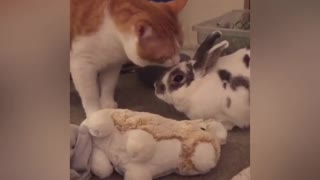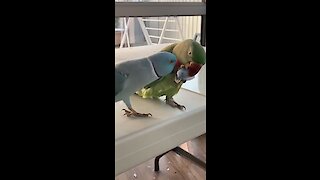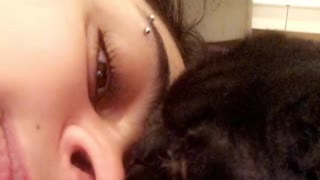Sweet young rescued kudu gives kisses to human friend
This 1-year-old Greater Kudu was rescued when he was just a baby, and had to be hand-reared, so he is very friendly and loves attention. He even shows affection back to his human friend! How precious is that?!
The Greater Kudu (Tragelaphus strepsiceros) is one of the largest species of antelopes, and it's known for its fence-jumping abilities, being able to easily jump fences that are 3 meters high, and even 3.5 meters, if needed! It is also known for its beautiful horns, making them the most commonly hunted species in Southern Africa.
It shares the Tragelaphus genus with seven other species: the Lesser Kudu (Tragelaphus imberbis), the Bongo (Tragelaphus eurycerus), the Imbabala (Tragelaphus sylvaticus), the Kéwel (Tragelaphus scriptus), the Sitatunga (Tragelaphus spekii), the Nyala (Tragelaphus angasii), and the Mountain nyala (Tragelaphus buxtoni). All of these species are large-sized, lightly built, have long necks, and spiral horns. They also have a considerable sexual dimorphism, which means that males and females look different. The Common Eland (Taurotragus oryx) used to also be in this genus, with the scientific name of Tragelaphus oryx. Is spite both being called Kudu, the Greater Kudu and the Lesser Kudu are not more closely related than the other members of the genus.
Only male Kudus have horns, and they only begin to grow between 6 and 12 months of age, twisting once around two years, and only reaching the full two and a half twists (occasionally three) at 6 years of age.
The Greater Kudu prefers habitats with mixed scrub woodland, acacia, and mopane bush on lowlands, mountains, and hills. They are water-dependent when the vegetation is too dry, but other than that, they can go for long periods without drinking water, getting enough moisture from their food.
They are a preferred species for game-ranching, for being browsers and, therefore, not competing with domestic livestock.
-
 0:31
0:31
NataliaCara
1 year agoAdorable rescued Crab-eating Fox pup wants to catch what's making the weird noise
131 -
 0:30
0:30
Dogacat
4 years ago $3.32 earnedSweet kitty gives doggy friend loving bath
7.75K8 -
 0:15
0:15
Winniethewunderbun
4 years agoCat Gives Kisses To Bunny Best Friend
17.9K9 -
 0:28
0:28
Luna
4 years ago $10.45 earnedParrot gives best friend kisses, complete with kissing sounds!
6.23K2 -
 0:37
0:37
Joluka
4 years ago $33.52 earnedFrench Bulldog lovingly gives kitty best friend some kisses
32.2K4 -
 0:13
0:13
Ashleaellenburg
4 years agoSweet kitty kisses
168 -
 0:14
0:14
ViralHog
4 years ago $0.41 earnedCute Kitty Gives Kisses on Command
1.2K -
 0:09
0:09
golden_daisydot
6 years ago $140.86 earnedSweet puppy gives baby precious kisses
3.14K2 -
 0:39
0:39
NataliaCara
4 years agoAdorable rescued Tayra loves sweet potato
7.74K6 -
 1:03
1:03
ViralHog
4 years ago $0.06 earnedMaking A Fast Friend With A Sweet Stray Doggy
3022